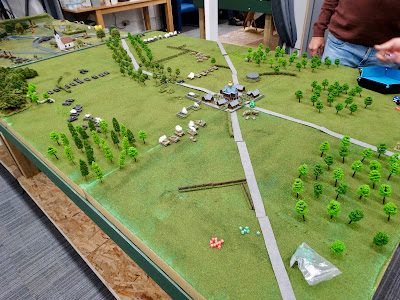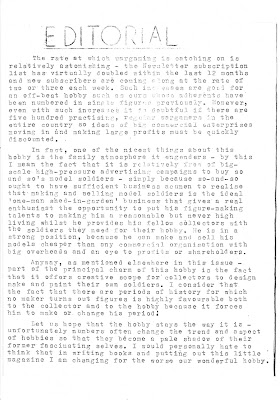Wargames, Soldiers & Strategy magazine issues 130 and 131 have both been corkers. Every now and then I get to thinking that wargames magazines have had their day, then I get proved wrong, usually by WSS. In both issues there were interesting articles, some useful scenarios, and interesting review sections. Oh yes, and some decent maps as well.
I know some of you find the 'think piece' articles, where issues around the way the hobby is developing are aired, a bit uninteresting - too much navel-gazing when we should be thinking about painting figures and playing games. For myself, I find them worthwhile. I spend a lot of my average day thinking about and planning my wargaming, plus the time I actually spend gaming, and I like to try and understand what I'm doing and why.
To cut to the chase, WSS130 contained an article by Richard Clarke (of the Too Fat Lardies, of course) called 'Naked Communication'. As you'd expect, it was well worth reading, and largely contained a lot of common sense. Broadly, it was about the kickback some of the bigger commercial wargaming companies occasionally get when they introduce new rules, new supplements and new figures for reasons that seem to have more to do with increasing revenue than looking after their customers. Of course, if you run and/or own a company, increasing revenue is your job. The problem is that miniature wargaming is largely an amateur undertaking, and ordinary wargamers can react adversely to what they see as commercialism.
This is the crux of Richard's article, and it was a couple of his statements concerning the amateur/professional relationship that made me want to write a response. Let's start with the first quote that made me think I disagreed with him.
"...pleased as we must be that the hobby is more accessible and that products are more available, we somehow retain an odd attachment to the amateur roots of the hobby."
'An odd attachment to the amateur roots of the hobby'. What's odd about being attached to the hobby's roots? Let's check out the definition of hobby:
'An activity that someone does for pleasure when they are not working.' (Cambridge Dictionary)
'An activity done regularly in one's leisure time for pleasure'. (Oxford Languages on Google)
So a hobby is by definition an amateur activity. It's not a job. Which makes that phrase 'the amateur roots of the hobby' rather suspect. Our hobby was an amateur one when it started, and it's still mostly amateur today. There are, of course, professional companies attached to the hobby, and their number seems to be growing. They are also quite often run by genuine and inspirational wargamers like Richard, so the lines are blurred. But that doesn't change the nature of the hobby.
Richard goes on to mention the influence of the internet, which he correctly identifies as massively positive, and the emergence of 3D printing, which he seems less certain about. He states that "it is a direct threat to the large figure and model making companies". In that he is obviously correct, but from the point of view of an amateur wargamer, the picture looks rather different. For me, 3D printing has enabled me to get miniatures I couldn't get from any established manufacturer, or miniatures I could get from an established manufacturer but of better quality for the same price or less. As soon as I became aware of the potential of 3D printing, I realised it would change what I called the 'balance of power' between the main commercial companies and ordinary wargamers. The cottage industry was back (just like the 60s, 70s and 80s), and individual gamers could even print their own high quality figures and models.
Now this is, of course, wonderful news, especially because it speaks directly to the 'amateur roots of the hobby'. To some extent, ordinary, amateur wargamers are taking back control. This is a feature of the influence of the internet as well, of course, although I reckon the commercial side of the hobby has benefited at least as much from the world wide web as us amateurs.
Richard saves the worst for last. He forsees "bigger companies asking, even insisting, that at their events you use their models when using their rules". Flames of War gathered some bad publicity a few years back when they tried this. I guess if a company is actually running a competition and footing the costs, then fair enough. But not something I would like to see becoming widespread. Such are the dangers of 'official' and 'commercial' wargaming.
And then this:
"If we want the hobby to survive, grow and prosper, we need to recognise that the amateur hobby is not one we want to return to."
I intend to recognise no such thing. We've already established that wargaming with miniatures is an amateur undertaking. So we're not really returning to anything, as we never really departed from it. Richard identifies a "vibrant and exciting hobby industry" as vital to the future of the hobby. Well, it's nice to have you guys around, and we all wish you the best, but if you're experiencing a bit of competition, welcome to the world of capitalism. 3D printing is the best thing to happen to this hobby for many years. It promises to set ordinary wargamers free from the commercial pressures suffered by full-time professionals. We can have what we want, when we want it, rather than when it suits the priorities of various wargaming companies. The 'hobby industry' will have to learn how to catch up. I hope they do.
Gamers will continue to protest from time to time about being told we have to do it differently now, because there's a new rulebook out, or a new range of figures. They can, of course, choose to just walk away, which some do. Well done guys. Do it the way it was before. Do it your way.
I should end by thanking Richard for a polite and thought-provoking piece which helped me clarify what the hobby is about and what it means to me. I think I should also say that the Too Fat Lardies have added a lot to the hobby and given a great deal of pleasure to a lot of gamers, including me. Sincere best wishes for the future, gentlemen. But I for one welcome any move back towards the hobby's roots. We can do this move in a modern way, with excellent 3D products tailored to our needs, and home-brewed, self-published rules with professional-level presentation. This is our hobby, where we all choose our own way of enjoying the pastime. This is what we must not lose, and this is what is vital to our gaming future. An amateur hobby is the natural state of things. Long may it continue.











































